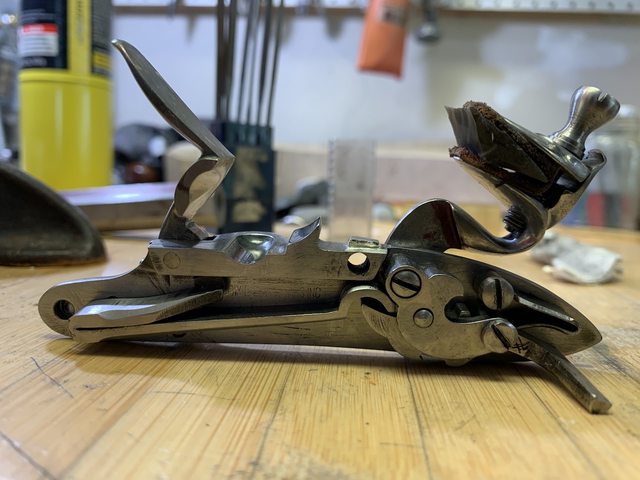westrayer
40 Cal
T/C and Lyman produce their locks with coil springs while it seems that everyone else goes with leaf spings. What are the advantages of each?

Coil wire springs are many times more reliable than are flat or V springs but the later give faster reaction (lock time). Also coil springs don't load up like flat and V as they are much longer (because of the coiling) and store energy over a longer power curve which generally means a smoother but slower power stroke.T/C and Lyman produce their locks with coil springs while it seems that everyone else goes with leaf spings. What are the advantages of each?

Whats increasing is the leverage as the cock is drawn further back but the energy load and tension is still sharply increasing into the flat or V spring. They are much shorter so the energy that is stored in them subtends less mass length which unloads and is transferred much faster to the work load.Hi,
Coil springs simply get stronger the further they are depressed so the force builds up during the entire cocking process. "V" springs, which have been used successfully for 5 centuries or more and are entirely reliable, can be designed and fitted such that the force needed to bring the lock back from rest to half cock is more than the force needed to bring it from half to full cock. In other words, it lets off a little allowing a lighter trigger pull. Coil spring locks usually feel rough and clunky and in most cases are fitted to set triggers so you don't experience a heavy trigger pull. You will find coil spring locks on mass produced muzzleloaders because they are cheap and easy to manufacture. High quality flint and percussion locks always have "V" springs.
dave
Yes, you're right, this one is by Leonardo da Vinci for a wheel lock pistol...Coil springs have been around for a long time, they were sometimes used in wheel lock guns.






Simply put , leverage increase !Coil springs are much easier to produce on a large scale, with close to no material waste, hence an order of magnitude cheaper.
The "let off" effect in a lock, i.e. the effort tu pull the cock diminishing as you approach full cock, is determined by the geometry of the tumbler and mainspring.
As you can see below, a properly designed tumbler and V mainspring have a much shorter lever/arm at full cock than at rest, meaning that you need less effort to move the cock near the end, since the mainspring is compressed over a shorter distance for the same amount of cock movement.
View attachment 343699
View attachment 343700
View attachment 343704
View attachment 343705
On a TC coilspring lock, instead, the arm length is basically the same at rest and at full cock, which makes the cock harder to pull the more the spring is compressed.
View attachment 343702
View attachment 343703
T/C and Lyman produce their locks with coil springs while it seems that everyone else goes with leaf spings. What are the advantages of each?
No comparison for smooth function in a Roller or Stevens 44. A strut and coil main spring conversion is light years ahead of the flat springs they are designed with..Depends on the purpose, is one better than the other, only in the same application, I’d probably chose the V spring for a mainspring or sear spring etc.
In a receiver, rolling block, bolt, or extractor i would want the coil spring.
Properly setup and tuned, the lever spring from HC to FC should actually decrease. When the "hook" on the mainspring almost touches the "inside" of the tumbler, that's setup right. So, when you look at the leverage from HC to FC, the spring compresses very little, if at all.Group,
Measured the force to move my hammer on a Lyman Trade rifle in 50 cal. This flintlock uses a coil spring.
From fired to half cock took 7 1\2 pounds. From half cock to full cock took 8 1\2 pounds. Spring scale was attached to the top of the flint jaw.
So, the force just increases as the coils are stretched (hooks law). I would be interested in the same measurements using a traditional flat spring with the curve on the spring end that changes the force relationship.
Marc
Enter your email address to join: